BALL, Albert [of Nottingham] VC
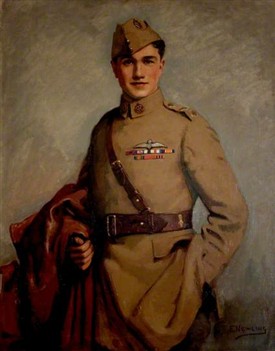
Albert Ball VC by Edward Newling
He did not, of course, ever wear the purple ribbon of the Victoria Cross since it was awarded posthumously
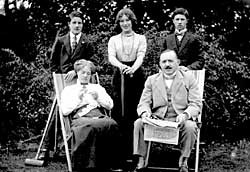
Sir Albert and Lady Ball with their children Cyril, Lois and Albert (right, behind his father)
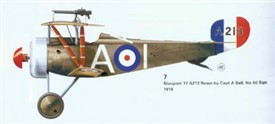
Ball's Nieuport
Note the red nose cone
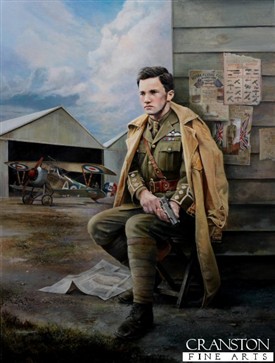
Albert Ball by Chris Collingwood
This picture captures some of the unsettling loneliness of the hero
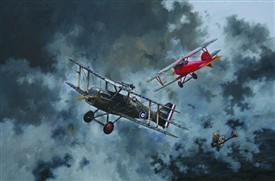
Ball's last fight
His SE5 is breaking away from Lothar von Richthofen's red Albatros
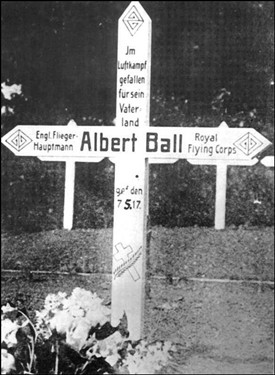
Original cross placed on Ball's grave by the Germans
'He fell in the air war for his fatherland'
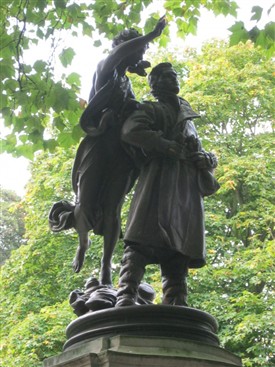
Albert Ball VC memorial
Nottingham Castle
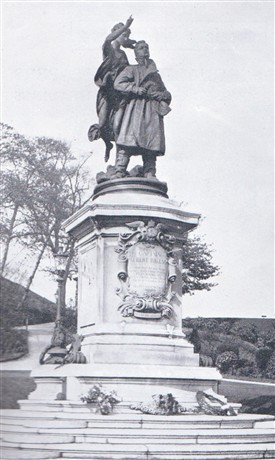
The Albert Ball VC memorial at Nottingham Castle when newly erected
It was unveiled by Air Marshal Trenchard in 1921
England's Richthofen?
By Ralph Lloyd-Jones
Albert Ball is far and away Nottingham’s greatest war hero from the First World War, or indeed any conflict in history. There is a magnificent statue of the famous pilot, who died aged just 20, in Nottingham Castle grounds. Many people who are not particularly interested in the War could name him.
He was born at 301 Lenton Boulevard on 14 August 1896, son of Harriet and Sir Albert Ball. His father, who did much to promote his son’s career and memory, was a master plumber and land agent involved in local politics. He had been Conservative Mayor of Nottingham and lived until 1946.
Because he had been educated at private schools, Nottingham High and Trent College, Long Eaton, the younger Albert was eligible to become an officer when war broke out. Having enlisted into the Sherwood Foresters he received his Commission in October 1914, but was frustrated at not being sent to the Front immediately. By getting up at the crack of dawn and riding his motorbike a long way (to Hendon, now site of the RAF Museum) he gained his Private Pilot’s Licence within a year and transferred to the Royal Flying Corps.
After starting with the less glamorous BE 2C aeroplanes and Bristol Scouts on reconnaissance and bombing missions with 13 Squadron, in May 1915 he was posted to 11 Squadron with its much better French-built Nieuport aircraft. Ball had exceptionally good eyesight, and his method was to spot a lone enemy at an enormous distance, fly up from behind and below him and shoot – using an upper wing-mounted machinegun that was aimed vertically above his head – directly into the belly of the unfortunate German aircraft. Most of them probably never even saw him.
So successful was this technique that he had won the Military Cross by June 25th. Albert Ball’s letters describe him living in his own little hut near his beloved Nieuport, creating a small garden and playing the violin. Ball invented the idea of making himself stand out individually by having the nose cone of his aircraft painted bright red, a trick to frighten the enemy which was later copied by Manfred von Richthofen in his famous all-red aeroplanes.
His contribution was recognised with decorations such as the Distinguished Service Order and two bars (i.e. three DSOs) by the end of 1916, the French Legion d’Honneur and the exotic Order of St George from an admiring Russian Tsar. He had also risen swiftly to the rank of Captain and was withdrawn from front-line duties to go and instruct other pilots back in England by way of a rest and in the hope that the trainees would learn some of his style. He even helped design a special ‘Ball’ fighter aircraft, though it never went into general production.
When, in February 1917, he returned to active duty with 56 Squadron he did not initially like the new SE5 aircraft and was glad to be allowed to stick to Nieuports. The Germans were by now using bolder aerial tactics and had even formed a special ‘Anti-Ball Squadron’, a great (and unique) testament. Although he achieved an incredible seven victories in five days (1 - 5 May 1917), Ball’s luck ran out on May 7th. He had been in a classic dogfight with several Germans, but appears to have lost his life by flying into a large cloud, becoming disorientated and emerging from it upside-down, possibly already unconscious, with the engine cut out. He was killed by the crash, not by any bullets, though Lothar, Manfred von Richthofen’s younger brother, claimed to have slain Ball. The Germans gave him a funeral with full military honours at Annouelin where he lies to this day, now with a more elaborate stone memorial than the original simple wooden cross (today in Trent College). He was posthumously awarded the Victoria Cross.